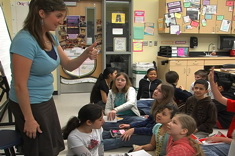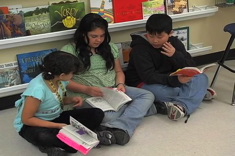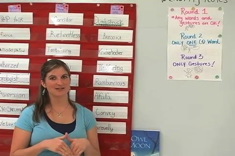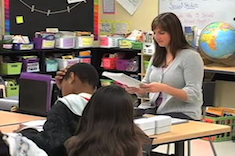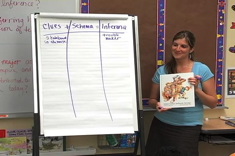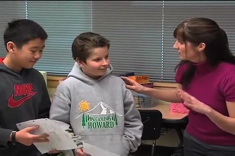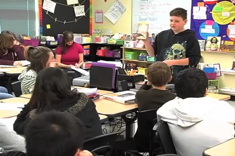There are several key components of a thriving literacy workshop. In my sixth-grade classroom, students need to:
- be able to read and discuss texts;
- feel comfortable with each other so they can openly share their thinking; and
- be willing and able to write for lengthy amounts of time.
Because there are so many things that need to be done at the start of the year, I incorporate many lessons in the first few weeks that build skills within this trifecta of necessities.
Early in the school year, I passed out a chapter from the book The House on Mango Street by Sandra Cisneros. The chapter is titled "My Name" and is a beautiful and poetic bit of prose. The narrator reflects on her name, and how she came to be call Esperanza.
Each of my students is given a copy of this short text, and we read it aloud. I ask my students to read it again silently, and highlight a sentence or phrase that really strikes them. Perhaps the words evoked a memory, or the reader simply liked the way the words came together to create meaning. Whatever the reason, the task is straightforward – find a small chunk of language that makes you stop and think. This gives us a jumping off point for the discussion that comes next.
After a few minutes of reading and reflecting, I ask my students to share the phrase or sentence, and their reasons for highlighting it with the people sitting at their table groups. The class is abuzz with chatter, and I cruise around to the tables to eavesdrop. I ask for a few volunteers to share the language that struck them, urging them to tell us why. After a child shares her thinking, I ask the class if anyone has a response — if someone chose the same portion of text, or if they have something to share about what they just heard. This skill of responding to each other is not intrinsic. It needs to be taught and modeled.
The conversations start simply enough, with chatter about specific lines. Soon the discussion shifts away from this scaffold, and incorporates deeper thinking. After Chris reflected that "My Name" sounded like a poem, Andre raised his hand and commented that he didn't really like how poetic the chapter was.
"If the lady was so sad, why not just say she was so sad? It's not like her sadness is sittin' on her elbow and all that. It makes it confusing." There were quite a few nods from students who agreed with Andre.
I respond, "Oh, interesting Andre. That is one of my favorite things about this piece. I love how poetic it sounds. For me there is so much meaning in this language that makes the reader really think about how the narrator and her great-grandmother really feel. Does anyone else want to share their opinion?" A few students share ideas. Then the class falls silent.
"So class, Andre and I as well as many of you are in complete disagreement about this writing style. Who is right? Those who like the poetry of it, or those who find it confusing or distracting?"
I look around at the class, and it really only takes a few seconds for kids to start murmuring. Some are saying 'the teacher' is right, and a few of Andre's friends are pointing at him. Meek, but just loud enough to be heard over the low din, Olive says, "You're both right."
"Exactly Olive! When we are discussing literature or any text, the fun of it is finding those disagreements or new ideas that challenge our own thinking. What Andre and I are disagreeing about is the writing style and word choice of the author. That's personal taste. Everyone had an opinion or thought or perhaps a connection to text. And as long as you can share your thinking and why you think that, then it is valid. If we all thought the same exact thing about everything we read, how boring our class discussions would be!"
The conversation continues and, perhaps because students feel more confident sharing their opinions, we have a lively discussion about the names Esperanza would choose if she could change her "muddy-colored" name.
"I think it's weird how she wants to change her name to ZeZe the X," Julie states. "I don't really get that name."
Kathy pipes up in response, "Oh! I thought that maybe it was really ZeZe the Ten, like how X is really a ten in Roman numerals."
"Oh yeah!" chimes in Liz. "In the beginning she says her name is like a nine! So maybe it is ZeZe the Ten!"
I look around the room. I have never considered this nor heard this line of thinking in years of using this piece with students. Many students are nodding and looking equally wowed. "That is something that I never considered – though I have often wondered how a name could be like the number nine. It's so cool how you connected the ending lines to those beginning lines. How many of you think that Kathy and Liz are really onto something here?"
Almost every hand is raised. There are a few holdouts who simply like the sound of ZeZe the X ("because it sounds like a super hero" I mention) better than ZeZe the Ten. But even the holdouts have to give Kathy and Liz credit. They have made us think about the text in a new way, and they made a pretty convincing argument in the process.
The conversation was a success. By modeling back and forth when necessary, and by urging the students to respond to each other the majority of the time, we start the school year off with successful conversing. The point of a discussion after all is not only to listen to what others think, but to respond to it as well.
Building on Successful Conversations
It is important for me to remember there is no guarantee that because this conversation went so well, subsequent conversations and discussion will be equally great. I will need to continue the sometimes laborious process of pulling thoughts and responses from my students. Inevitably, some discussions will flop. Some discussions on the same topic will be incredible in one class, and pathetic in another. But as the teacher, I must continue to facilitate, encourage, and lure information from the minds of my students. Sometimes this may feel like I am losing a game of tug-of-war, but only by keeping at it and making it a habit will boisterous discussion eventually readily occur. By actively drawing out responses from students at the start of the school year, and throughout the year with lessons like this, I practice that skill.
With an activity like this, it is necessary to call my students' attention to what we are doing. It's not a secret. We are developing listening and conversational skills that will be essential for our work together in the coming year, and essential for my students as critical thinkers. They need to know this. They need to understand that responding to each other has a purpose and helps us connect to each other, and more often than not, learn something new about ourselves, each other, literature, and the world around us.
To take this one step further, and to add the "get to know each other" element, I ask each student to share with a partner how they got their name and what it means. If they don't know why their parents chose their name, that's fine — It will make for good conversation when they get home from school.
After this conversation, I have another whole-class discussion. This time, I ask for volunteers to introduce their partner and to tell us his or her name and what they learned about their new classmate. For example, Alexis told the class, "Hi, my name is Alexis, and this is my partner Mariana. Mariana's name means 'of the sea or bitter' (she shoots a quick questioning glance at Mariana who nods encouragingly) and she's not sure why her parents named her that."
"I think we can be sure that Mariana is far from bitter," I reply and this comment elicits a chuckle from Mariana and several classmates. Laughter often serves to bring us closer together.
The more time my students spend in the center of the classroom limelight sharing their thinking, the faster our classroom becomes a community.
Writing Extensions
After this brief conversation, the writing starts. At this point, my students have had the opportunity to delve into Cisneros' writing and Esperanza's thinking about her name. They have shared their knowledge of their own names with a partner, and learned about a classmate's name as well. After all this reading and discussion of names, I turn my students to their writing binders and let them loose. They are asked to write about their own names as 'Esperanza' did. They can share what it reminds them of, what they like or dislike, why they were named that name, or anything that pops into their heads. The goal is to write as much as possible, as quickly as possible. We are gathering future writing ideas, and building our writing stamina.
"Write what your mind wants to say," I tell the students, and I hope their thoughts run wild. I always start out writing with students as we settle in to ten or so minutes of uninterrupted writing time. After everyone starts to write, I begin to creep around the room to read over shoulders. Some students struggle. They have only a few sentences written: "My name is Damon. I hate my name."
Others are letting go and writing with passion:
"My middle names are uncommon. I got them both from my grandmothers and they sound like the window of heaven opening. Mercy."
As in most classrooms, my students have widely varying abilities. Activities like this help me know where to go from here. I know the more opportunities we have to write, the more minds will open. And the more triple threat activities we do, the more success we will have in our writing and reading workshops.

